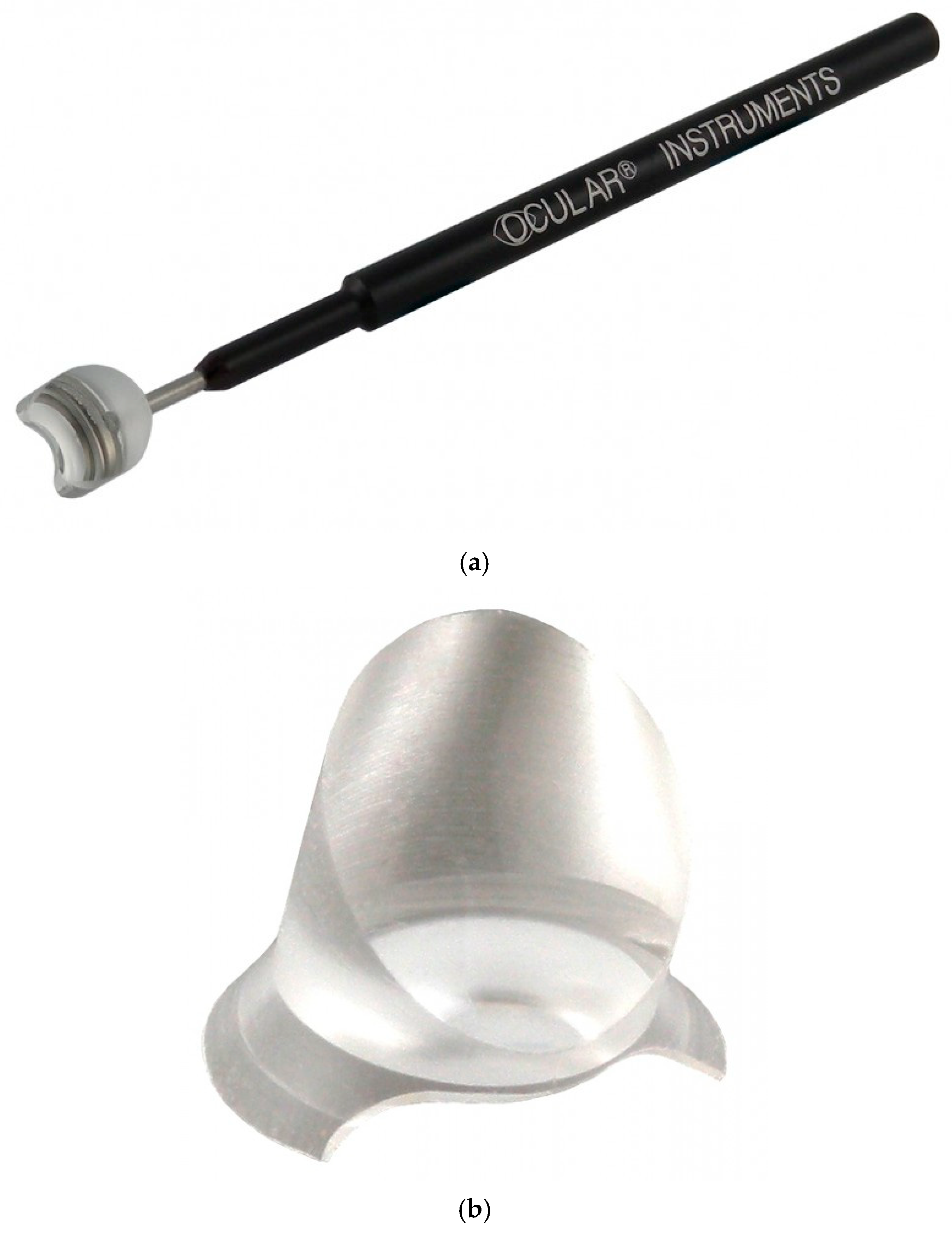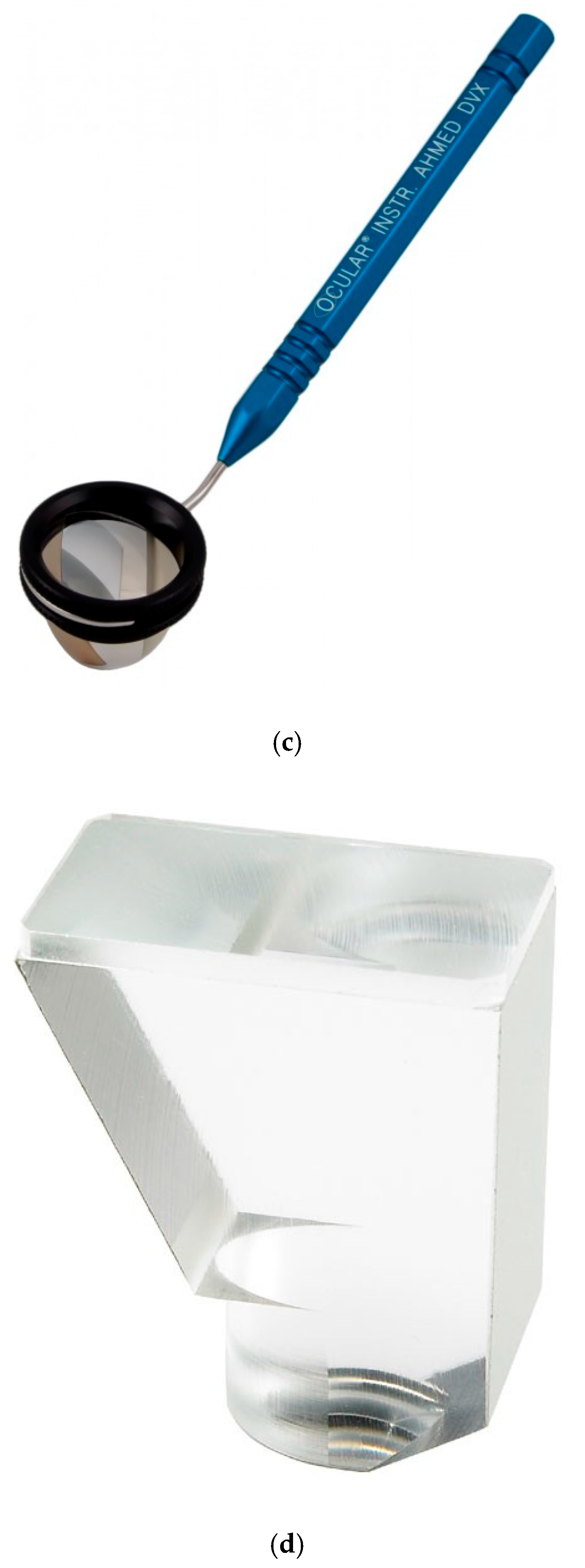Comparison of Surgical Times for Gonio Lenses and Viewing Systems in iStent Inject® W Surgery
Abstract
1. Introduction
2. Materials and Methods
2.1. Case Background
2.2. Surgical Method
2.3. Statistics
3. Results
4. Discussion
5. Conclusions
Author Contributions
Funding
Institutional Review Board Statement
Informed Consent Statement
Data Availability Statement
Acknowledgments
Conflicts of Interest
Abbreviations
| SPSS | Statistical Package for the Social Sciences |
| PEA | Phacoemulsification and Aspiration |
| IOP | Intraocular Pressure |
| MIGS | Minimally Invasive Glaucoma Surgery |
| DAS | Digitally Assisted Surgery |
References
- Matoba, R.; Morimoto, N.; Kawasaki, R.; Fujiwara, M.; Kanenaga, K.; Yamashita, H.; Sakamoto, T.; Morizane, Y. A nationwide survey of newly certified visually impaired individuals in Japan for the fiscal year 2019: Impact of the revision of criteria for visual impairment certification. Jpn. J. Ophthalmol. 2023, 67, 346–352. [Google Scholar] [CrossRef] [PubMed]
- Spiegel, D.; Wetzel, W.; Haffner, D.S.; Hill, R.A. Initial clinical experience with the trabecular micro-bypass stent in patients with glaucoma. Adv. Ther. 2007, 24, 161–170. [Google Scholar] [CrossRef] [PubMed]
- Japanese Guidelines for Use of iStent Trabecular Micro Bypass in Combination with Cataract Surgery. J. Jpn. Ophthalmol. Soc. 2020, 124, 441–443.
- Mori, K.; Ikushima, T.; Ikeda, Y.; Kinoshita, S. Double-mirror goniolens with dual viewing system for gonio surgery. Am. J. Ophthalmol. 2007, 143, 154–155. [Google Scholar] [CrossRef] [PubMed]
- Yu, L.; Li, Y.Y.; Tang, Y.H.; Li, G.X.; Zhang, S.D.; Zhang, Q.; Liang, Y.B. Early intraocular pressure spike after phacoemulsification with intraocular lens implantation and gonio synechialysis in primary angle-closure glaucoma. Sci. Rep. 2022, 13, 1192. [Google Scholar] [CrossRef]
- Manning, D.K.; Haider, A.; Clement, C.; Viswanathan, D. Efficacy and safety of iStent inject implantation in manual and femtosecond laser-assisted cataract surgery before lens extraction. J. Curr. Glaucoma Pract. 2022, 16, 105–110. [Google Scholar] [CrossRef] [PubMed]
- Qian, Z.; Wang, H.; Fan, H.; Lin, D.; Li, W. Three-dimensional digital visualization of phacoemulsification and intraocular lens implantation. Indian J. Ophthalmol. 2019, 67, 341–343. [Google Scholar] [CrossRef] [PubMed]
- Suzuki, T.; Fujishiro, T.; Sugimoto, K.; Aihara, M. Three-dimensional heads-up surgery in ab-interno trabeculotomy: Image processing-assisted trabeculotomy. PLoS ONE 2022, 17, e0263588. [Google Scholar] [CrossRef] [PubMed]
- Kantor, P.; Matonti, F.; Varenne, F.; Sentis, V.; Pagot-Mathis, V.; Fournié, P.; Soler, V. Use of the heads-up NGENUITY 3D Visualization System for vitreoretinal surgery: A retrospective evaluation of outcomes in a French tertiary center. Sci. Rep. 2021, 11, 10031. [Google Scholar] [CrossRef] [PubMed]
- Kunikata, H.; Abe, T.; Nakazawa, T. Heads-up macular surgery with a 27-gauge microincision vitrectomy system and minimal illumination. Case Rep. Ophthalmol. 2016, 7, 265–269. [Google Scholar] [CrossRef] [PubMed]
- Ohno, H. Utility of three-dimensional heads-up surgery in cataract and minimally invasive glaucoma surgeries. Clin. Ophthalmol. 2019, 13, 2071–2073. [Google Scholar] [CrossRef] [PubMed]
- Masahiko, A.; Toshiyuki, K.; Hitoshi, N.; Masanao, K.; Takeo, O.; Shigeo, Y. Quantitative evaluation of the learning process of phacoemulsification by senior and junior ophthalmologists, The Showa University. J. Med. Sci. 2005, 17, 89–94. [Google Scholar] [CrossRef]
- Ferguson, T.J.; Dockter, Z.; Bleeker, A.; Karpuk, K.L.; Schweitzer, J.; Ibach, M.J.; Berdahl, J.P. iStent inject trabecular microbypass stent implantation with cataract extraction in open-angle glaucoma: Early clinical experience. Eye Vis. 2020, 7, 28. [Google Scholar] [CrossRef] [PubMed]


| Swan–Jacob | Disposable | Ahmed DVX | Mori | |
|---|---|---|---|---|
| Microscope tilt | 70° | 70° | Unnecessary | Unnecessary |
| Magnification | 1.2× | 1.2× | 1.3× | 0.8× |
| View angle (°) | 90 | 90 | 120 | 110 |
| Eyepiece (mm) | 9.5 | 15.5 | 10.0 | 11.5 |
| Handle | With | Without | With | Without |
| Cost ※1 | USD 650.00 | USD 30.00/unit ※2 | USD 1050.00 | USD 850.00 |
| Group M | Group A | Group D | |
|---|---|---|---|
| Removal of viscoelastic material injection needle from inside the eye | 〇 | 〇 | 〇 |
| The surgeon moves to the temporal side | 〇 | ||
| Tilt the microscope | 〇 | 〇 | |
| Change in patient’s head position | 〇 | 〇 | |
| Adjusting the position of the microscope | 〇 | 〇 | |
| Put the gonio lens on the cornea | 〇 | 〇 | 〇 |
| Observe the angle | 〇 | 〇 | 〇 |
| Group M | Group A | Group D | |
|---|---|---|---|
| Removal of iStent inject W® from the anterior chamber | 〇 | 〇 | 〇 |
| The surgeon moves upward | 〇 | ||
| Change in patient’s head position | 〇 | 〇 | |
| Restore the tilt of the microscope | 〇 | 〇 | |
| Adjusting the position of the microscope | 〇 | 〇 | |
| Observe the anterior chamber | 〇 | 〇 | 〇 |
| Group M | Group A | Group D | p-Value | |
|---|---|---|---|---|
| No. (eye) | 24 | 19 | 25 | |
| Age (years) | 74.4 ± 6.4 | 73.0 ± 6.6 | 71.4 ± 10.7 | 0.62 |
| Male: Female | 11:13 | 8:11 | 17:8 | 0.17 |
| Right: Left (eyes) | 13:11 | 9:10 | 12:13 | 0.91 |
| Group M | Group A | Group D | p-Value | |
|---|---|---|---|---|
| Preparation time (seconds) | 54.5 ± 18.2 | 20.9 ± 5.6 | 51.6 ± 14.1 | <0.01 |
| Recovery time (seconds) | 19.5 ± 5.9 | 9.6 ± 4.6 | 20.0 ± 5.3 | <0.01 |
Disclaimer/Publisher’s Note: The statements, opinions and data contained in all publications are solely those of the individual author(s) and contributor(s) and not of MDPI and/or the editor(s). MDPI and/or the editor(s) disclaim responsibility for any injury to people or property resulting from any ideas, methods, instructions or products referred to in the content. |
© 2025 by the authors. Licensee MDPI, Basel, Switzerland. This article is an open access article distributed under the terms and conditions of the Creative Commons Attribution (CC BY) license (https://creativecommons.org/licenses/by/4.0/).
Share and Cite
Fujii, T.; Sakanishi, Y.; Morita, S.; Ebihara, N. Comparison of Surgical Times for Gonio Lenses and Viewing Systems in iStent Inject® W Surgery. J. Clin. Med. 2025, 14, 3680. https://doi.org/10.3390/jcm14113680
Fujii T, Sakanishi Y, Morita S, Ebihara N. Comparison of Surgical Times for Gonio Lenses and Viewing Systems in iStent Inject® W Surgery. Journal of Clinical Medicine. 2025; 14(11):3680. https://doi.org/10.3390/jcm14113680
Chicago/Turabian StyleFujii, Tatsuya, Yoshihito Sakanishi, Shuu Morita, and Nobuyuki Ebihara. 2025. "Comparison of Surgical Times for Gonio Lenses and Viewing Systems in iStent Inject® W Surgery" Journal of Clinical Medicine 14, no. 11: 3680. https://doi.org/10.3390/jcm14113680
APA StyleFujii, T., Sakanishi, Y., Morita, S., & Ebihara, N. (2025). Comparison of Surgical Times for Gonio Lenses and Viewing Systems in iStent Inject® W Surgery. Journal of Clinical Medicine, 14(11), 3680. https://doi.org/10.3390/jcm14113680







